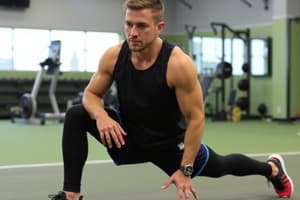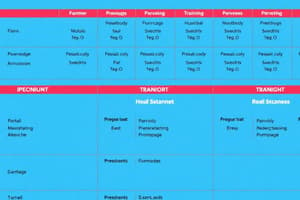Podcast
Questions and Answers
What is the correct sequence for exercise order during a training session?
What is the correct sequence for exercise order during a training session?
- Assistance, Power, Core
- Power, Core, Assistance (correct)
- Core, Assistance, Power
- Assistance, Core, Power
What is a primary advantage of alternating upper and lower body exercises?
What is a primary advantage of alternating upper and lower body exercises?
- Prevents muscle fatigue in both muscle groups (correct)
- Increases overall workout time
- Provides no real benefits to training
- Allows for quicker adaptation to resistance training
Which of the following is an example of a power exercise?
Which of the following is an example of a power exercise?
- Knee extension
- Squat
- Power clean (correct)
- Arm curl
What defines a superset in resistance training?
What defines a superset in resistance training?
Which type of training involves performing exercises with minimal rest periods?
Which type of training involves performing exercises with minimal rest periods?
What describes the purpose of alternating push and pull exercises?
What describes the purpose of alternating push and pull exercises?
What is a compound set in resistance training?
What is a compound set in resistance training?
Which of the following exercises is categorized as an assistance exercise?
Which of the following exercises is categorized as an assistance exercise?
What is a recommended training frequency for many athletes to ensure adequate recovery?
What is a recommended training frequency for many athletes to ensure adequate recovery?
How does the training load impact recovery time for athletes training with maximal loads?
How does the training load impact recovery time for athletes training with maximal loads?
What is a common training technique for advanced athletes to promote strength gains?
What is a common training technique for advanced athletes to promote strength gains?
What is the maximum recommended number of consecutive training days focusing on the same muscle groups?
What is the maximum recommended number of consecutive training days focusing on the same muscle groups?
Which factor may limit the time available for resistance training during certain periods?
Which factor may limit the time available for resistance training during certain periods?
Which of the following is true about training frequency in relation to physical stress?
Which of the following is true about training frequency in relation to physical stress?
For athletes with extensive experience, which training approach may be beneficial?
For athletes with extensive experience, which training approach may be beneficial?
What should athletes do if they lack specific resistance training equipment?
What should athletes do if they lack specific resistance training equipment?
What is the SAID Principle?
What is the SAID Principle?
Which of the following exercises would be considered a core exercise?
Which of the following exercises would be considered a core exercise?
Which best describes the difference between structural and power exercises?
Which best describes the difference between structural and power exercises?
Which of the following exercises is NOT a good example of jumping specificity, progressing from most to least specific?
Which of the following exercises is NOT a good example of jumping specificity, progressing from most to least specific?
What is the ideal ratio of knee flexor to extensor strength?
What is the ideal ratio of knee flexor to extensor strength?
Why is it important to ensure athletes properly demonstrate exercises before training?
Why is it important to ensure athletes properly demonstrate exercises before training?
Which of the following is NOT a factor to consider when designing a resistance training program?
Which of the following is NOT a factor to consider when designing a resistance training program?
What is the primary difference between a core exercise and an assistance exercise?
What is the primary difference between a core exercise and an assistance exercise?
Flashcards
Resistance Training Equipment
Resistance Training Equipment
Equipment used for building muscle strength and endurance.
Training Frequency
Training Frequency
The number of training sessions in a specified time period.
Importance of Rest Days
Importance of Rest Days
Rest days are crucial to allow muscle recovery between workouts.
Recommended Workouts for Athletes
Recommended Workouts for Athletes
Signup and view all the flashcards
Split Routine
Split Routine
Signup and view all the flashcards
Heavy vs Light Training Days
Heavy vs Light Training Days
Signup and view all the flashcards
Sport Season Impact
Sport Season Impact
Signup and view all the flashcards
Training Load
Training Load
Signup and view all the flashcards
Exercise Order
Exercise Order
Signup and view all the flashcards
Power Exercises
Power Exercises
Signup and view all the flashcards
Core Exercises
Core Exercises
Signup and view all the flashcards
Assistance Exercises
Assistance Exercises
Signup and view all the flashcards
Upper and Lower Body Alternation
Upper and Lower Body Alternation
Signup and view all the flashcards
Push and Pull Exercises
Push and Pull Exercises
Signup and view all the flashcards
Supersets
Supersets
Signup and view all the flashcards
Compound Sets
Compound Sets
Signup and view all the flashcards
Structural Exercises
Structural Exercises
Signup and view all the flashcards
Sport-Specific Exercises
Sport-Specific Exercises
Signup and view all the flashcards
Muscle Balance
Muscle Balance
Signup and view all the flashcards
Agonist Muscle
Agonist Muscle
Signup and view all the flashcards
Exercise Technique Experience
Exercise Technique Experience
Signup and view all the flashcards
Study Notes
Program Design: Exercises
- Program design focuses on exercise selection, type, frequency, and order.
- Exercise selection considers exercise type (core, assistance, structural, power, and sport-specific), technique experience, equipment availability, and session time.
- Core exercises recruit large muscles and multiple joints, prioritized for sport application.
- Assistance exercises involve smaller muscles and single joints, important for injury prevention and rehabilitation.
- Structural exercises emphasize spine loading; power exercises are structural movements performed explosively.
- Sport-specific exercises mirror sport actions to enhance positive transfer.
- Exercise technique experience is crucial; athletes must demonstrate correct form.
- Equipment availability may necessitate substitutions.
- Time constraints may lead to the prioritization of time-efficient exercises.
Step 2: Exercise Type
- Core exercises recruit one or more large muscle groups, two or more primary joints and prioritized when selecting exercises.
- They are important in sport's application.
- Assistance exercises recruit smaller muscle areas, involve only one primary joint, and are less crucial to sport performance.
- They are common in injury prevention and rehabilitation.
- Load and repetitions are often different.
Step 2: Structural and Power Exercises
- Structural exercises emphasize loading the spine, either directly or indirectly.
- Power exercises are structural exercises performed swiftly or explosively.
Movement Analysis
- Training specificity (SAID Principle) necessitates training similar to actual sport movements.
- Considering the plane of movement, muscles, and movement speed is important for exercises resembling sport performance.
- Examples of jumping specificity are power cleans, back squats and leg presses.
Muscle Balance
- Muscle balance represents the balance of muscular strength across joints and opposing muscle groups.
- Agonists are muscles actively causing movement.
- Antagonists are sometimes passive muscles located on the opposite side of the limb.
- Optimal muscle balance is not always equal strength but a correct ratio of strength, power or muscular endurance.
Step 2: Exercise Selection
- Exercise technique experience must not assume proper form.
- Athletes must demonstrate correct form.
- Instruction is necessary if athletes require improvement.
- Equipment constraints may necessitate substitutions for specific exercises.
- Prioritizing time-efficient exercises is important when time is limited.
3) Frequency
- Training status influences rest days between training sessions.
- Sport season can limit training time.
- Training loads and exercise types need more recovery time.
- Other training, including aerobic and anaerobic training, sport skill practice, and physically demanding occupations all affect training frequency.
- Three workouts per week are recommended for many athletes.
- Frequency varies according to training status.
Step 3: Training Frequency (Table 17.4)
- Novice: 2-3 sessions per week.
- Beginner: 2-3 sessions per week.
- Intermediate: 3-4 sessions per week.
- Advanced: 4-7 sessions per week.
Key Point
- The general guideline is to schedule sessions with at least one rest or recovery day between sessions stressing the same muscle group.
- Intermediate and advance athletes can use a split routine to train different muscle groups on different days.
Split Routine Example (Table 17.5)
- Different split routine frequencies (4,5 or 6 times/week) are possible based on the individual athlete.
- This table shows a possible split routine.
Step 3: Training Frequency (Sport Season) (Table 17.6)
- Seasonal demands can limit resistance training time.
- Off-season: 4–6 training sessions per week.
- Preseason: 3–4 training sessions per week.
- In-season: 1–3 training sessions per week..
- Postseason (active rest): 0–3 training sessions per week.
Step 3: Training Load and Exercise Type
- Athletes performing maximal training loads need extra recovery time prior to the next session.
- Alternating heavy and light training days stimulates strength gains whilst allowing sufficient recovery for advanced athletes.
- This is especially crucial for multi-joint exercises.
Step 3: Other Training
- Training frequency is influenced by overall physical stress.
- Other aerobic or anaerobic training, sport practice and physically demanding occupations also need consideration.
4) Exercise Order
- Power exercises, other core exercises, then assistance exercises.
- Alternating upper and lower body exercises.
- Alternating "push" and "pull" exercises (e.g., bench press/bicep curl).
- Supersets and compound sets.
Step 4: Exercise Order
- Exercise order is the sequence of resistance routines in a training session.
- Power, Other Core (multijoint), then Assistance exercises.
- Upper and Lower Body exercises alternated.
- "Push" and "Pull" exercises alternated.
- Supersets and Compound Sets.
References
- Haff & Triplett. Essentials of Strength Training & Conditioning, 4th edition. Human Kinetics, 2016.
Studying That Suits You
Use AI to generate personalized quizzes and flashcards to suit your learning preferences.




